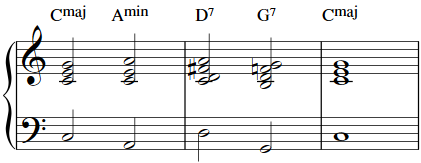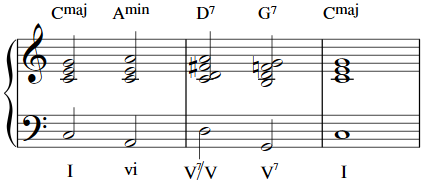In this article we are going to demystify secondary dominant chords and the confusion that often accompanies this music theory topic. Even if you’ve never heard the term “secondary dominant chords” before, you’ve probably encountered them regardless of what kind of music you like to play. That’s because secondary dominant chords are present in all types of music – jazz, classical, rock, folk, pop, etc. Understanding these chords will improve your theory knowledge, harmonic analysis understanding, composition skills, and transcription abilities.
Secondary Dominant Chords: What Are They?
Let’s start with diatonic chords. Diatonic chords refer to the chords which result when we build a chord on each note of the a major scale. Below are the diatonic chords, and their Roman numeral names, in the key of C major. These Roman numerals represent a formula which will be the same in every major key (i.e., the ‘I’ chord will always be major, the ‘ii’ chord will always be minor, etc).

Ok, now let’s breakdown what a secondary dominant chord is. First of all, secondary dominant chords are dominant chords, and dominant chords are 7th chords (major triad with a minor 7th on top). If we make 7th chords out of all the diatonic chords above, we only have one dominant chord – G7, the ‘V7’ chord.

And what do dominant chords do? They resolve to their ‘I’ chord. Dominant chords want to move in a ‘V to I’ resolution. So dominant chords function as the ‘V7’ of a ‘I’ chord, and they pull to that ‘I’ chord.
Now we’ve reviewed what a dominant chord is, but what is meant by the term secondary? ‘Secondary’ refers to the fact that secondary dominant chords come from outside of the key. So a secondary dominant chord is, by definition, any dominant chord that is not diatonic to the key.
Look at the chord progression below:

Do you see the dominant chord that does not fit in the key of C major? That’s right, the D7 chord. It’s a secondary dominant.
Secondary Dom7 Chords: How Do They Work?
Now let’s understand how secondary dominant chords work. In a nutshell, a secondary dominant chord is borrowed from another key. So when you see a secondary dominant chord you have to ask yourself, “This secondary dominant is the ‘V7’ of what chord?” Looking at the chord progression above ask yourself, “D7 is the ‘V7’ of what chord?” The answer is that D7 is the ‘V7’ of G. And lo and behold, which chord comes after the D7 chord? Well, G7, of course.
So the secondary dominant (D7) is a chord from outside the key that brings us to a chord inside the key (G7).
Lastly, we refer to this D7 chord as a “V7/V” (read “five-seven of five” chord).

Secondary Dominants: How Does This Info Help Me?
Understanding secondary dominant chords raises your musical awareness and understanding. You now know what a secondary dominant chord is, how to label it (with Roman numerals), how it functions, and why it is used. Practice playing the progressions above to get a sense of what secondary dominants sound like.

